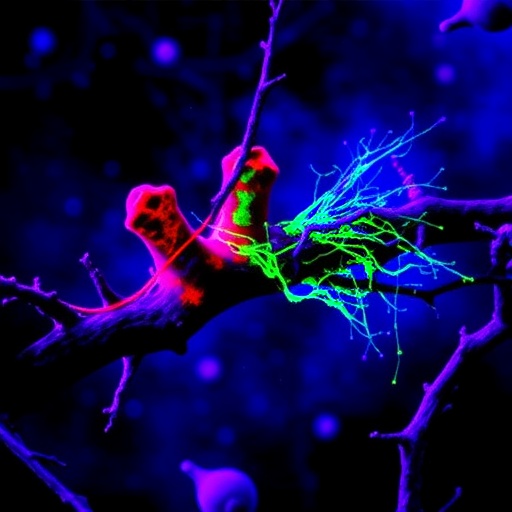In a groundbreaking development that could reshape our understanding of cancer biology, scientists have uncovered a highly specific molecular interaction with profound implications for cell proliferation and tumor progression. The study, recently published in Nature Communications, reveals a novel RNA-based regulatory mechanism in which a circular RNA molecule, circMAN1A2(2,3,4,5), directly binds to the mRNA of centromere protein B (CENPB), modulating its function and consequently influencing cancer cell growth. This discovery not only challenges conventional paradigms about RNA function but also opens new avenues for therapeutic intervention in various cancers.
Circular RNAs (circRNAs) have emerged in recent years as pivotal regulatory elements in gene expression networks. Unlike linear RNAs, circRNAs form closed-loop structures resistant to exonucleases, enabling them to function as molecular sponges, regulators of transcription, and even templates for protein translation in some contexts. However, the direct binding of circRNAs to specific messenger RNAs (mRNAs) to regulate their stability and translation has remained elusive until now. The research conducted by Cao et al. propels the field forward by demonstrating that circMAN1A2(2,3,4,5) directly interacts with CENPB mRNA, influencing cellular behavior in a cancer-specific manner.
At the core of this study is the centromere protein B (CENPB), a critical component of the centromeric chromatin that facilitates proper chromosome segregation during mitosis. Dysregulation of CENPB has been implicated in genomic instability, a hallmark of malignant transformation. By intricately binding to CENPB mRNA, circMAN1A2(2,3,4,5) modulates the expression of this centromere-associated protein. This, in turn, affects mitotic fidelity and cell cycle progression, contributing to the unregulated proliferation characteristic of cancer cells.
The authors employed a comprehensive suite of molecular biology techniques, including RNA immunoprecipitation, RNA fluorescence in situ hybridization (FISH), and luciferase reporter assays, to elucidate the nature and consequence of the circMAN1A2(2,3,4,5)-CENPB interaction. Their data compellingly show that circMAN1A2(2,3,4,5) stabilizes CENPB mRNA, enhancing its translation by protecting it from degradation pathways. This layered regulation adds another dimension to our understanding of post-transcriptional gene control in oncogenesis.
Moreover, functional assays revealed that manipulation of circMAN1A2(2,3,4,5) levels significantly altered proliferation rates in cancer cell lines derived from various tumor types, including lung, breast, and colorectal cancers. Knockdown of the circRNA led to reduced CENPB protein expression, impaired centromere function, and a consequent decline in cellular division rates. Conversely, overexpression amplified tumorigenic phenotypes, highlighting the circRNA as a potent driver of cancer progression.
Importantly, the research pinpointed the molecular interface between circMAN1A2(2,3,4,5) and CENPB mRNA, identifying specific nucleotide sequences responsible for their interaction. This high-resolution mapping enables the possibility of designing therapeutic molecules—such as antisense oligonucleotides or small-molecule inhibitors—that can disrupt this interaction, potentially halting tumor growth at a molecular level.
The implications of this study extend beyond its immediate findings. The identification of a direct circRNA-mRNA interaction as a modulator of cell cycle dynamics introduces a previously underappreciated class of gene regulation, especially in the context of cancer. This may lead researchers to re-examine other circRNAs and their potential intra-RNA interactions, potentially uncovering a network of regulatory loops that orchestrate cellular homeostasis and pathogenesis.
The investigation also underscores the value of viewing RNA molecules not merely as intermediaries in gene expression but as active participants in regulatory circuits with tangible phenotypic outcomes. The circMAN1A2(2,3,4,5)-CENPB axis exemplifies this principle, offering a tangible nexus point between noncoding RNA biology and essential cellular machinery.
From a therapeutic standpoint, targeting circRNAs offers unique advantages. Their structural stability and often cell-type-specific expression patterns make them attractive drug targets, potentially lowering the risk of off-target effects typical of conventional therapies. Moreover, disrupting the circMAN1A2(2,3,4,5)-CENPB interaction might complement existing treatments by selectively impeding cancer cell proliferation without affecting normal cells.
Leading oncologists and molecular biologists have lauded the study for its innovation and clinical relevance. Dr. Elena Martinez, a noted expert in RNA oncology, remarked, “This research substantially shifts the paradigm of RNA-based regulation in cancer. By unveiling a direct, functionally significant interaction between a circRNA and an essential cell cycle regulator, it opens a new frontier in precision medicine.”
The study also raises intriguing questions about the evolutionary origins and conservation of such RNA-based interactions. If circRNAs can fine-tune the expression of key mitotic proteins, it suggests a sophisticated evolutionary layering of gene regulation that permits resilient control over cell division—a feature that cancer cells co-opt to fuel their unchecked growth.
Furthermore, the spatial localization of circMAN1A2(2,3,4,5) within the nucleus and cytoplasm suggests multifaceted roles in post-transcriptional regulation, potentially involving coordination with RNA-binding proteins and the broader transcriptomic landscape. Such complexity invites further exploration into the interplay between RNA species and chromatin architecture in the context of cellular proliferation.
Future research directions highlighted by the authors include the exploration of circMAN1A2(2,3,4,5)-CENPB interactions in vivo, utilizing animal models of cancer to validate therapeutic potential. Additionally, high-throughput screening for compounds that can selectively disrupt this interaction stands as an exciting prospect for drug developers aiming to target this newly identified regulatory axis.
In sum, the discovery of direct circRNA-mRNA interaction between circMAN1A2(2,3,4,5) and CENPB mRNA sets a new benchmark in RNA research, deepening our grasp of molecular oncology and signaling a promising new chapter in the fight against cancer. This study exemplifies how cutting-edge molecular tools combined with creative inquiry can illuminate the hidden layers of gene regulation with profound clinical significance, offering hope for novel, more effective cancer therapies in the near future.
Subject of Research: Direct interaction between circular RNA circMAN1A2(2,3,4,5) and CENPB mRNA and its role in regulating cell proliferation and cancer progression
Article Title: Direct circMAN1A2(2,3,4,5)-CENPB mRNA interaction regulates cell proliferation and cancer progression
Article References:
Cao, M., Yuan, G.H., Cao, S.M. et al. Direct circMAN1A2(2,3,4,5)-CENPB mRNA interaction regulates cell proliferation and cancer progression. Nat Commun 16, 8609 (2025). https://doi.org/10.1038/s41467-025-63686-7
Image Credits: AI Generated
Tags: cancer cell growthCENPB interactioncentromere protein BcircMAN1A2circular RNA regulationgene expression networksmolecular spongesnovel cancer biology discoveriesRNA function in cancerRNA-based mechanismstherapeutic intervention in cancertumor progression





